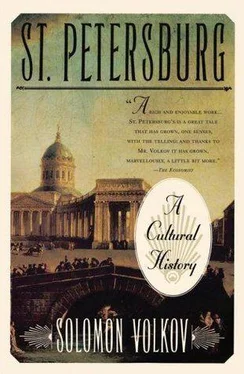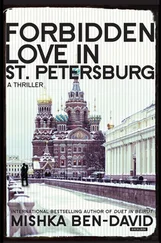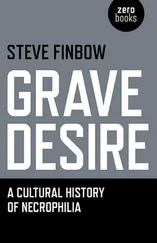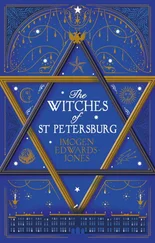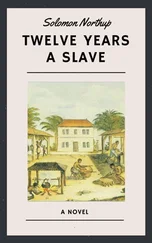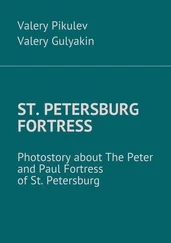Pushkin, who thought that Peter “despised humanity perhaps more than did Napoleon,” was puzzled: “It is worth pondering: the difference between Peter the Great’s state accomplishments and his temporary ukases. The former are the fruit of a broad mind, imbued with good will and wisdom, the latter are often cruel, willful, and, it seems, written with the knout.”
The tsar’s knout whistled mercilessly and constantly, so the city grew at incredible speed. Declared the new capital of Russia in 1717, it had over forty thousand residents by 1725, toward the end of Peter’s reign—an eighth of the country’s urban population. The emperor had succeeded in building a unique monument: not a pyramid, or a cathedral, but an entire city that quickly overshadowed the former capital, Moscow.
Under the jealous and impatient eye of Peter—which usually led to one architect beginning some building or other, a second one continuing it, and a third completing it—were built the Peter and Paul Fortress and the Admiralty, with their proud spires, the Twelve Collegia (ministries established by Peter on the European model), and the most famous and beloved of Petersburg’s beautiful public parks, the Summer Gardens, creating the stylish rectangle that for the next one hundred fifty years set the tone for the construction of Petersburg.
State establishments had to be built with a pomp worthy of a great empire, although the emperor personally still preferred simple rooms for himself, where everything was functional. His house in the Summer Gardens had a carpentry workshop, with a sign the tsar put on the door: “No one without orders or who has not been called inside may enter, be he stranger or a servant of this house, so that at least here the master may have a quiet place. Peter.”
To amuse himself, Peter went to the most luxurious house in Petersburg—the stone palace of the capital’s first governor, Menshikov. It is characteristic of Peter’s upwardly mobile Russia that Menshikov, a man without a noble lineage but hardworking, sneaky, merry, and brilliant, went from being a hot-pastry vendor to the tsar’s batman and then to the highest positions in the empire. Light and air poured into the huge windows of the palace, which stood on Vasilyevsky Island, on the banks of the Neva. The large main dining room had tables along the walls each of which could hold a whole roasted bull.
Peter and Menshikov’s other guests ate a lot and drank even more. A fat court jester rode the room on a small horse and shot a pistol every time the tsar drained his goblet. That was the signal for deafening cannon fire on the embankment which overpowered even the roars of Peter’s inebriated entourage. A foreign visitor noted that on such occasions more gunpowder was used up than for the storming of some fortresses.
Peter himself sliced the enormous pies that were brought in one after another. One time a beautiful female midget jumped out of a pie completely naked except for some red ribbons. The tsar and his guests were delighted, for Peter loved dwarves, jesters, and all kinds of monsters, and the imperial court had dozens of them.
Once the guests had stuffed themselves, they danced until two in the morning. The physically inexhaustible Peter adored the energetic Western dances and forced his overweight boyars to jig, too; this was an obligatory part of his “civilizing” program for Russian society. The emperor particularly insisted that old men with gout dance; he was amused by their suffering. Once they caught their breath they went back to the table to continue the party till dawn. No one dared go home or even leave the room without Peter’s permission. Foreign ambassadors fell to the floor and instantly fell asleep. Guests urinated on them, while Peter held the candle.
The tsar was not known for his fastidiousness. Pushkin relates, in the historical notes he collected under the English title Table Talk, the following story:
Once a little Negro servant who accompanied Peter I on a walk stopped to relieve himself and suddenly shouted in terror: “Sire! Sire! My intestine is coming out!” Peter came over to him, looked, and said, “Liar: that’s not an intestine, it’s a tapeworm!”—and he pulled the tapeworm out with his fingers.
Pushkin concludes, “The anecdote is rather dirty, but it depicts Peter’s customs.” The morning after such a party, they took a hair of the dog and then went to one of Petersburg’s thirty or so bathhouses. The men’s and women’s baths were next to each other on the riverbank. They undressed right in the street and went inside to steam. When the heat became too much for them, they ran out and jumped into the river. In winter, when the river froze, the lobster-red giant of a tsar and his entourage could be seen frolicking naked in the snow.
And always after a relaxing drinking interlude came more stressful, exhausting work. Peter once described himself as a man pulling uphill while millions pulled downward. But those passive and obedient slaves considered themselves innocent victims of the tsar’s whims, the most trying of which was the creation of St. Petersburg. The underlying hostility toward the new city was expressed in folk legends and prophecies that crystallized simultaneously with the construction of Petersburg even before it was completed.
According to one such instant legend, perhaps the most popular, Eudoxia, Peter’s first wife, whom the tsar forcibly exiled to a convent, cursed the new city: “Sankt-Peterburg will stand empty!” {15} 15 8 M. I. Semevskii, Slovo i delo! 1700-1725 (Word and Deed! 1700-1725) (St. Petersburg, 1884), p. 88.
This pronouncement clashes head-on with Peter’s no less famous “The city will be here!” Word of mouth spread about the kikimora, a dreadful mythic creature that hopped into the bell tower of the Trinity Church (Petersburg was founded on the day of the Trinity). {16} 16 9 Ibid., pp. 87-90.
This was also supposed to foretell the quick destruction of the city, and nature itself suggested the source: the almost annual floods repeatedly wreaked havoc in the city.
The grim “underground” mythology about Petersburg persisted in spite of the official imperial mythology, which was sparkling and optimistic. In the official hierarchy, Peter the Great was a demiurge and his creation, Petersburg, stood as a result of nothing less than divine inspiration. In the folk consciousness, every change Peter wrought on Russia, and especially the new, rootless capital that had devoured so many Russian lives, was the result of the devil’s machinations. So the masses nicknamed Peter the “Antichrist tsar.” The belief in the imminent end of Petersburg, which would also bring the end of the world, was widespread in Russia at that time. Resentful comments overheard about the “cursed city” or the “Antichrist tsar” brought complainers swiftly before the dreaded Secret Chancellery both during Peter’s lifetime and after his death in 1725. They were then beaten mercilessly with the knout, burned with hot irons, broken on the rack, or had their tongues torn out. But the anti-Petersburg talk didn’t cease. Although it was suppressed, it created a constant accompaniment for the continuing expansion and beautification of the capital.

In the sixty years after Peter’s reign, Russia had six rulers, the result of early deaths and palace coups. Of them, if we omit Peter’s niece, the tall and heavy Anna Ioannovna (during whose reign, 1730-1740, Petersburg was twice desolated by suspicious fires, which greatly simplified the official policy to transform the city from wooden buildings to stone), only one consistently pursued Peter’s dream of a modern “New Rome”—his daughter the Empress Elizabeth, who came to the throne with the support of the palace guards in 1741.
Читать дальше
